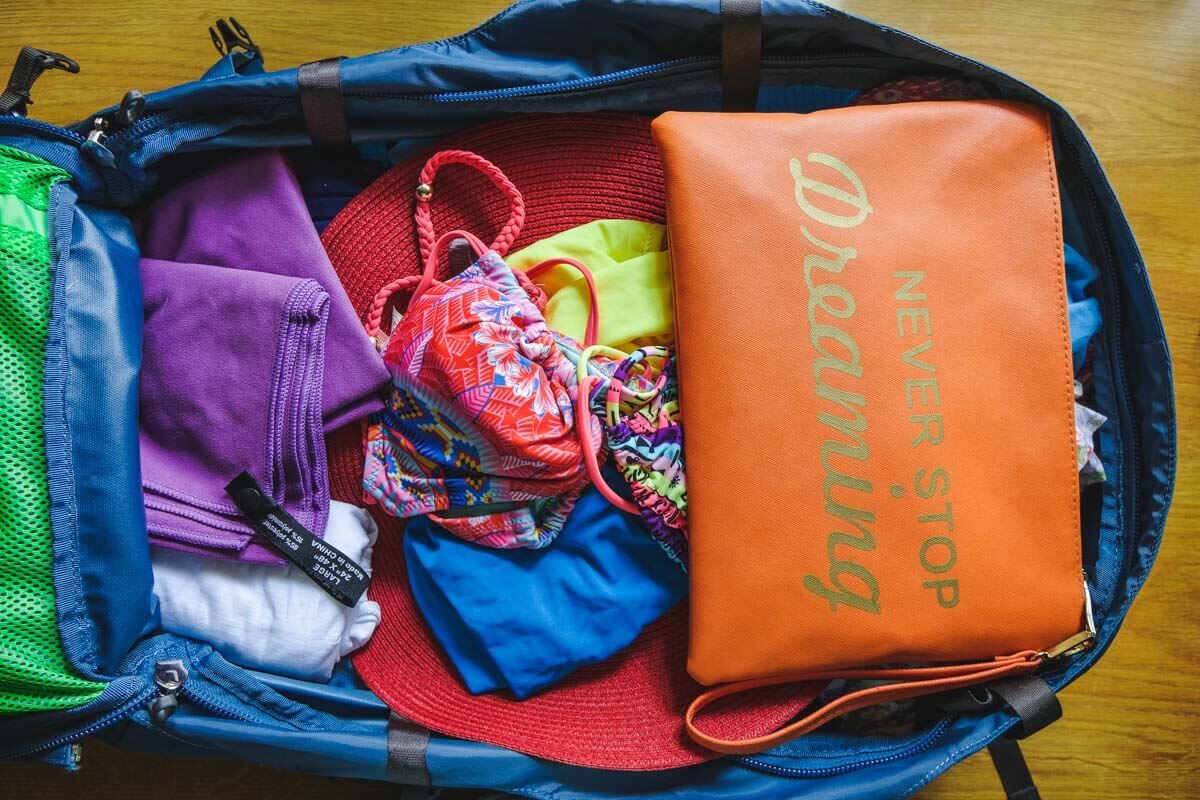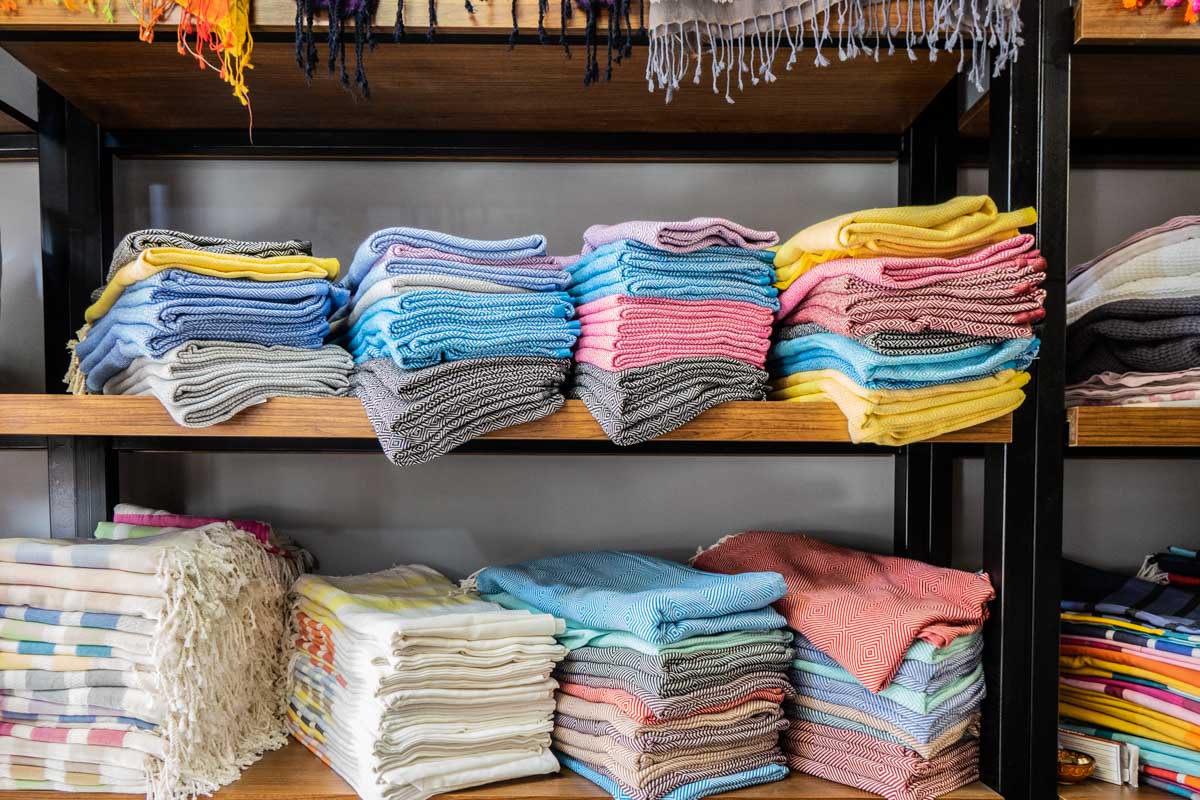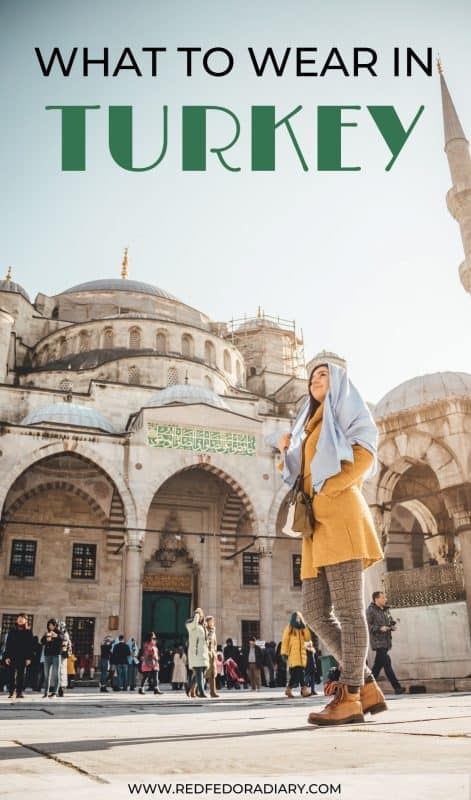What to Wear in Turkey: Turkey Packing List for Women & Men
What to wear in Turkey can be confusing for many travelers, especially for women and remote areas. Turkey’s location spanning Europe to Asia, encircled by seas, and uneven terrain running along the Black Sea, makes the climate here highly variable.
Among other Muslim countries, Turkey has a relatively relaxed clothing etiquette. However, it does depend on where you go. The major cities don’t have any strict dress codes. It’s essential to know the rules of what to wear in Turkey and what to pack for Istanbul, Ankara, Cappadocia, and other cities.
This Turkey packing list gives all the essential items for both women and men to bring to Turkey.
Turkey packing list essentials
Generally, when traveling to a country, I always advise packing as lightly as possible. This makes moving around easy and flexible if you plan to visit several cities. If you are flying into Istanbul with a budget airline such as Pegasus, the chances are that you’ll only have carry-on luggage.
Even though airport buses all over Turkey have a designated luggage compartment, you still want something small enough to squeeze it somewhere when using small intercity minivans.
Backpack or suitcase? – Oto and I travel with backpacks anywhere we go as it is much more comfortable for us, especially in the hilly or unpaved areas. Moreover, dragging a rolling suitcase makes me walk slower and is very noisy in the cobbled streets.
For example, many roads in Istanbul are old with no proper sidewalks, and rolling a suitcase might be challenging. I have a 55 Liter Osprey Farpoint, and Oto has Cobra 60 from The North Face. Both are spacious but small enough to carry on board many budget airlines. Check out the in-depth review of my Osprey Backpack.

Day pack or purse/bag – besides your main bag or suitcase, I recommend bringing a small bag to use when exploring cities. My Osprey backpack has a daypack that Oto uses most of the time. It has several compartments, so we carry essential and valuable items.
Alternatively, we also own a bag explicitly made for city wanderings – CITYC 2 in 1 Backpack from Driibe (get 15% off with code: FEDORA15).
Scarf – I rarely travel without a scarf, no matter the season. However, depending on the season, I change it accordingly. I use it on breezy evenings, for sun protection, as a pillow, you name it. It’s especially vital for women to cover up their heads and shoulders when traveling to Turkey and visiting its mosques. I have this versatile, quick-drying Turkish beach towel/scarf.
Hat – if you’ve been following my travels here or over Instagram, you know that one thing I rarely travel without is my red fedora hat. Bring a hat if you come here in summer, spring, or autumn. It’s valuable both in sunny and rainy weather. Oto travels with a cap in spring/summer or a beanie in autumn/winter.
Luggage tag – even if you are not checking in your luggage, it’s always a good idea to have a luggage tag on them. Intercity buses in Turkey tag your bags, but you should have your own for extra security.
Packing cubes – this is a live saver when traveling light and minimalist. They come in different sizes and shapes; some even have laundry bags. We use packing cubes for various clothes, especially those clothes that wrinkle easily. Small ones are great for socks and underwear. Here is the brand we have at the moment.
Toiletries bag – we travel with one toiletry bag as we don’t use that many liquids and hygiene product that would require two separate bags. We now use solid shampoo bars, soaps, deodorants, and toothpaste tablets that are zero waste, lighter, and avoid pouring liquids into small plastic bottles. We have this one from The North Face.
Moreover, the transition to solid hygiene products ensures that we go through airport security much easier. Check out my post on all the eco-friendly products we use.
Power adapter – sockets in Turkey are standard, just like in Europe, some parts of Asia, and Australia. They are 220 volts and 50 Hz frequency. Some five and four-star hotels provide North American-style sockets with 120 volts and 60 Hz frequency, but having the universal adapter is handy.
Water bottle – generally, tap water in Turkey is safe to drink; however, most locals widely use bottled ones for consumption, especially in Istanbul. Bringing and refilling your own water bottle will save you money and won’t add to the country’s massive plastic usage habit. I love my Stojo collapsable water bottle that saves lots of space in my backpack.
Battery charger – Turkey is a very photogenic country, and you’ll be exhausting your smartphone battery very soon, taking pictures in every corner. Moreover, using maps also drains the phone battery, so always bring an external charger to keep you on the go. I recommend Anker power chargers for their durability and quality.
What to wear in Turkey for women and men
We all have our core packing list; therefore, this packing guide won’t include how many pairs of underwear, socks, or t-shirts you should bring. This packing list for Turkey consists of the country’s culture and climate essentials.
Dress code for Turkey
As I mentioned above, what to wear in Turkey depends on the destination, the activities you plan on doing, and the time of the year. For instance, Istanbul, Ankara, and Izmir are pretty modern regarding the dress code, while many other cities and regions, such as eastern Turkey, are still very conservative.
When visiting Istanbul or Ankara, consider bringing modern and youthful clothes. The same goes for Cappadocia and other very touristy places where people are used to seeing women and men in all sorts of clothes. I have two of these flowy skirts.
If you plan on spending your vacation on islands and beaches, the dress code for Turkey and its seaside resorts is mostly very similar to those of European countries. You’ll be fine in a swimsuit but pack a modest cover-up.
As a rule of thumb, avoid strapless or backless shirts and dresses, anything that’s too relieving, including leggings. Also, men should avoid bringing mini shorts or tank tops when exploring some cities.
Visiting mosques
There’s a dress code when entering mosques. And the famous Blue Mosque has a rigorous rule. Generally, women need to cover their heads with a scarf. Avoid wearing shorts, sleeveless shirts, vest tops, short skirts, or leggings when visiting Turkey’s mosques.
You might be asked to wrap a shawl if someone at the door thinks your outfit is inappropriate. Therefore, come prepared or bring something of your own rather than use those that others have used.
Men have a more relaxed rule. However, you should still not wear shorts or sleeveless tops. Dress modestly as well and come in pants and a usual t-shirt.
Entering mosques with shoes is forbidden. Most of the mosques do have shelves to store your shoes. And as you’ll be exploring many mosques in Turkey, it’s better to bring easy-to-remove shoes with you. Sandals in summer or late spring/autumn are a great choice.
Consider bringing a separate shoe bag to store your shoes in your backpack or carrying them with you. You might end up waiting in line to get to the shoe shelf in busy and famous mosques, which get crowded quickly. Moreover, leaving your shoes unattentive with such a big crowd might be unsafe. I would also advise packing a separate pair of socks when exploring mosques.
Exploring cities
People in Istanbul, Ankara, and Izmir dress similarly to European cities. Fitted dresses, mini skirts, and sleeveless tops are standard here. So are jeans for both men and women.
You’ll also find women of all ages wearing burqas or just a headscarf paired with long sleeves and knee-long clothes. However, my advice is to respect the culture and traditions wherever you go in Turkey, even in bigger cities – dress modestly and think of smart casual.
To consider what to wear in Turkey while exploring various cities is to pack very comfortable shoes. Most popular cities are like open museums of gorgeous architecture and city life, so you’ll walk a lot here.
Such shoes also come in handy when exploring the valleys in Cappadocia with uneven terrain and offroad pathways. I usually pack one sandal with my Reebok sneakers if I travel in late spring, early autumn, or summer.
What to wear in Turkey in spring and autumn
Spring and autumn in Turkey are usually mild. However, sudden cold and hot weathers are characteristic of both seasons, with occasional rainfall. Despite that, both seasons are good when visiting the country as the temperature is warm enough to enjoy days out exploring the cities with smaller crowds.

- Lightweight coat or jacket – you’ll be fine with a spring/autumn light coat or jacket in most cities. However, if you plan on visiting eastern Turkey, you might reconsider bringing wintery clothes. You might also want to throw in a packable raincoat.
- Boots or sneakers – sneakers are absolutely fine when walking through the valleys of Cappadocia in spring or autumn.
- Scarf – pack a warm scarf or this versatile, quick-drying Turkish beach towel/scarf in case the weather changes during the day.
- Cardigan or sweatshirt – layering clothes come in handy as the temperatures vary depending on where you go. Weather can be a bit unpredictable.
- Jeans – pack one pair of jeans.
What to wear in Turkey in summer
Summers in Turkey are generally dry and hot. The temperature can quickly go above 30 C during the day. While May is usually the wettest month, July and August are the driest.
- Light clothes – think of loose and lightweight, long dresses/skirts and pants for women. I always travel with one pair of jeans just in case the weather goes crazy. Men should also bring long and light pants or convertible shorts.
- A light cardigan or a shawl – even though summers in most popular destinations are hot, it doesn’t mean that evenings are hot too. Indoor places might also have their A/C on high, so having a light cardigan or a shawl that doesn’t take up much space can be handy.
- Comfortable sandals or sneakers – you’ll be walking a lot, remember? So do your legs a favor and opt-in for those shoes that won’t hurt your feet after an hour of walking.
- Fancy clothes – through in “just in case” elegant attire for a nice dinner at a rooftop bar in Istanbul or a nice restaurant.
What to wear in Turkey in winter
The winter here starts in mid-December and ends in mid-March. The weather conditions differ according to the region, and temperatures can vary from -7 to -24 C, depending on the area.
The snow-covered cities of Turkey are absolutely stunning. However, this beauty also means a heavy breeze in the cities perched by the water. Therefore, make sure your Turkey packing list includes the following:
- The warm waterproof jacket is obvious, but I am still pointing out that it often rains and snows during the winter almost everywhere in Turkey, depending on the region. To save some space in your luggage, consider this foldable raincoat.
- Layers of clothes – as you’ll be walking pretty much the whole day, pack a thermal top and leggings to wear under a shirt/sweater and jeans. Cold days in Istanbul are fierce, with freezing winds blowing on all sides of the streets.
- Waterproof shoes or ankle-high boots – similar to the jacket, this might be obvious. I lately travel with my Timberland boots in cold/mild seasons. Oto wears either Back-To-Berkeley or this high-ankle snow boots.
- Scarf – the warmer and fluffier the scarf is, the better it suits its purpose.
- Other accessories – hats, gloves, and anything you’d wear in a winter destination
Turkey packing list for long bus travel
Of all the countries I have been to, bus travel, be it short or long, is the most comfortable I have experienced thus far. If you’ll travel a long distance by bus, from Istanbul to Cappadocia or vice versa, for instance, here are some tips for traveling in Turkey by bus.
Travel pillow – if you can, bring a travel pillow with you. Alternatively, you can also find small-size pillows at most bus stations. But don’t rely on them; it’s better to be prepared, plus they are not super comfortable either.
Some entertainment – most intercity buses offer free Wi-Fi, but in most cases, they are unreliable or have a weak connection. Also, most of those buses have TVs showing movies, but they are all Turkish! Therefore, to kill some time during your long bus travel, bring some entertainment, be it a Kindle, an audiobook, or a podcast episode.
Tip: I use the Airalo app, which provides local eSIMs for a more affordable internet connection when traveling. Get 3 USD with code: BAIA2592.
Snacks – buses do have their designated stops during the journey. They stop at local roadside restaurants, or Lokantası in Turkish, for around 20-30 minutes. Those places are clean and offer all sorts of local food. However, if you don’t feel like eating there, bring your snacks to nibble on. However, avoid anything with a distinctive smell that can disrupt other travelers.
Coins – on those roadside stops, you’ll need coins to use the bathroom. Sometimes, there’s a person at the entrance who takes money and can give you a change, but in some areas, it’s a coin-operated entrance with no one at the door. So have at least 5-10 TL worth of coins to be safe.
Turkey packing list for hammam
Hammam is a Turkish steam bath, but it’s a widespread public bathing phenomenon in the Islamic world. Going to a hammam is one of the experiences you must have in Turkey. Do note that men and women bathe in different rooms, and there are no private rooms in public hammams. So here’s what you’ll need for a comfortable visit:
Bring swimwear – it’s advised for both men and women to bring swimwear or extra underwear. Generally speaking, being naked in a hammam is a common rule, but you should still cover your genital area.
For men, it’s common to wrap themselves in a lightweight peştamal, pronounced as Peshtemal, a quick-dry Turkish cotton towel. Women wear only their underwear. However, you can keep your bikini top on if you are uncomfortable. Although the less skin you cover, the more it can absorb the steam and get all the benefits.
You can buy in before your trip to Turkey or buy in once you arrive there.

Own hygiene products – some small local hammams might charge you a bit extra to buy shampoo or soap, so bring your own. Hammam also includes a good scrub massage, so either bring your own luffa (kese in Turkish) or buy one at one of the shops. Just tell them you need it for the hammam, as there’s a special one for the experience.
Slippers or flip-flops – bring your own slippers, even though some may provide them in the dressing room.
Towel – to dry yourself after all the procedure hammam has to offer. I always have my microfiber towel with me anywhere I travel.
Bag – to carry your wet swimsuits, towel, and slippers. Check these wet bags specifically made for such trips
My favorite travel Resources
✈ Book affordable flights on WayAway, a platform that shows the best flight deals, tours, and hotels. With a WayAway Plus membership, you can earn cashback. Get 10% off with code: RFD10
🚫 Get compensation for up to 700$ with Airhelp if your flight was canceled or delayed within the last 3 years.
🚗 Rent a car with DiscoverCars, a trusted international car rental website.
💻 Get a VPN from Surfshark to protect your devices from hackers when using public Wi-Fi when traveling.
📱 Install the Airalo app, which provides local eSIMs for a more affordable internet connection when traveling. Get 3 USD with code: BAIA2592.
💸 Use Wise to withdraw money in local currency without hidden fees and avoid high exchange rates. On top of that, you might get a Visa or Mastercard debit card.
🏨 Find budget-friendly deals on all sorts of accommodation types on Booking.com.
❣ Pre-book a private car transfer with Welcome Pickups to your hotel.
🩺 Buy the most flexible and budget-friendly travel insurance, SafetyWing, covering COVID with add-ons for adventure sports and electronics theft.
☀ Book in advance some of the best city walks, cultural experiences, and day tours to maximize your stay and experience here.

Want more inspiration?
